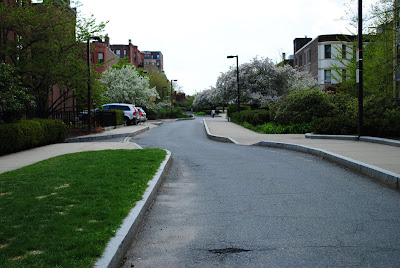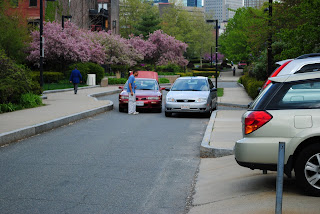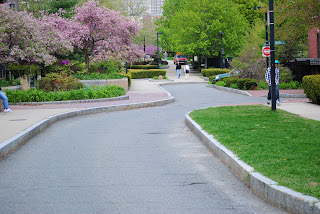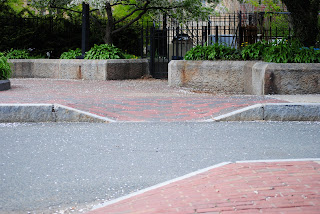Posted by Katrina Martinez


Claremont St. is a part one-way, part two-way narrow road that connects three residential streets with alley ways that are used for parking behind residential buildings. Claremont St. runs along SW Corridor Park's wide multi-use path. On the map it labels the path as "SW Corridor Park", however, technically the whole park area is actually 'SW Corridor Park'. This is a 4.7 mile, 52-acre, linear park stretching from the Back Bay to Forest Hills.

From the close up of the map you can see that Claremont St is the only way to access the parking areas between Greenwich Park and Claremont Park and Claremont Park and Wellington St. Claremont St. also connects to the parking area between W Rutland Square and Greenwich Park, but this alley is also accessible from an additional parking alley running perpendicular to it that connects to W Rutland Square and Greenwich Park.
The majority of cars using Claremont St. are the residents of these four roads (Wellington St., Claremont Park, Greenwich Park, and W Rutland Square) accessing parking behind their buildings. Also, all four of these roads are two-way with residental parking on both sides, therefore residents that are parallel parked on these streets will use Claremont St. as a turn around path to get to Colombus Ave. instead of making a K-turn.

Because Claremont St. runs along the multi-use path of SW Corridor Park they have clearly designed it for the safety of park users so that vehicles won't go fast down the street, and also so vehicles won't park on the street, causing unnecessary traffic. The first main feature of this design is the width of the street (14 ft). The average car width is 6 ft, so this barely provides enough space for two cars to pass each other and makes it impossible to park on without essentially blocking the whole road. While I was observing the street one vehicle did park along it while the owner unloaded flowers. As seen in the picture, he parked where it intersects an alley way, so the only way other vehicles could get around him was to drive into the alley.


Claremont St. is partially a one-way street, but it's tricky understanding exactly where. Here I've shown on a map exactly how the layout goes. I've also labeled the parking alleys for better clarity. The only thing indicating these one ways are "Do Not Enter" signs on Claremont St. at the SW corners of Claremont Park/Claremont St. and Greenwich Park/Claremont St. Therefore traffic entering Claremont St. from alley '1', Greenwich Park, and Claremont Park must turn left. However traffic coming from alley '2' can turn both way, but if they turn right they must go down Greenwich Park to exit. Also note that there is no way of entering alley '1' from Claremont St., hence the alternate access way.

The second main design feature is the path of the road. The road is not a straight line, it bends slightly right or left between every intersection. This makes vehicles (along with the narrow width) automatically slow down and does not allow them to achieve high speeds. The last main feature is the high curbs. The curbs on Claremont St. are approximately 9 inches, while and average curb is about 6 inches. I feel this serves for two main purposes. First to make a vehicle feel more restricted, and in turn causing them to slow down. Also to discourage pedestrians/bicyclists to walk in

the street. However, in saying that, I also have to note that there are a lot of pedestrian ramps along the road and it is interesting to see the much more extreme angle of decline in t
hem. I didn't observe any handicapped pedestrians use them, but I would consider that due to the high curbs and more extreme ramps, if it would be more difficult for pedestrians in wheelchairs (or walkers, crutches, etc) to use the ramps.

Overall I believe Claremont St. does exactly what it is intended to do. All the vehicles that I observed drove through the street at a very slow speed. I find it doubtful that any car would try to (or even want to) park along the street. The volume of cars was low, as well as vehicle conflict.


 Claremont St. is partially a one-way street, but it's tricky understanding exactly where. Here I've shown on a map exactly how the layout goes. I've also labeled the parking alleys for better clarity. The only thing indicating these one ways are "Do Not Enter" signs on Claremont St. at the SW corners of Claremont Park/Claremont St. and Greenwich Park/Claremont St. Therefore traffic entering Claremont St. from alley '1', Greenwich Park, and Claremont Park must turn left. However traffic coming from alley '2' can turn both way, but if they turn right they must go down Greenwich Park to exit. Also note that there is no way of entering alley '1' from Claremont St., hence the alternate access way.
Claremont St. is partially a one-way street, but it's tricky understanding exactly where. Here I've shown on a map exactly how the layout goes. I've also labeled the parking alleys for better clarity. The only thing indicating these one ways are "Do Not Enter" signs on Claremont St. at the SW corners of Claremont Park/Claremont St. and Greenwich Park/Claremont St. Therefore traffic entering Claremont St. from alley '1', Greenwich Park, and Claremont Park must turn left. However traffic coming from alley '2' can turn both way, but if they turn right they must go down Greenwich Park to exit. Also note that there is no way of entering alley '1' from Claremont St., hence the alternate access way.
The analysis seems to miss the point made in the title, about how high curbs discourage parking. Your photo shows that people are *almost* ready to park on a street 14 ft wide; making it 13 ft wide might have been a better idea.
ReplyDelete